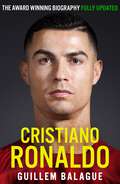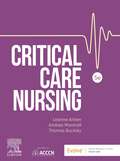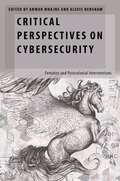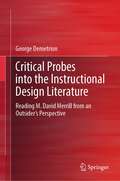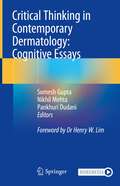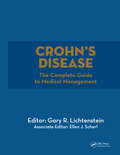- Table View
- List View
Crisis Communications: A Casebook Approach (ISSN)
by Kathleen Fearn-Banks Kevin KawamotoNow in its sixth edition, this book provides engaging, practice-oriented case studies analyzing communication professionals’ crisis preparation and responses, illustrating key considerations for communicating with both internal and external stakeholders during and after a crisis.This edition continues its strength as a student-friendly text that demonstrates how to craft, target, and deliver messages during crises in order to mitigate further controversy and distress. Classic cases lay the foundation, while contemporary cases shed light on cutting-edge practices in use today. Many cases from previous editions have been updated and new cases added, including the COVID-19 crisis and U.S. vaccination campaign; Starbucks and racial discrimination at a Philadelphia branch; Will Smith and the Academiy Awards slap; Gander, Newfoundland in supporting stranded tourists after the attacks of September 11, 2001; and a look at how schools can prepare communication responses to school shootings. Each case pays particular attention to the actual and ideal use of social media in the crisis and there is a new section on the important issues of misinformation and disinformation.Crisis Communications, 6th Edition is intended for courses in crisis communication, crisis management, disaster response, corporate communications, and public relations.Student and instructor online support materials feature selected previous editions’ case studies no longer in this edition as well as an Instructor’s Manual with suggested activities, discussion questions, and sample quizzes: www.routledge.com/9780367894450.
Crisis Communications: A Casebook Approach (ISSN)
by Kathleen Fearn-Banks Kevin KawamotoNow in its sixth edition, this book provides engaging, practice-oriented case studies analyzing communication professionals’ crisis preparation and responses, illustrating key considerations for communicating with both internal and external stakeholders during and after a crisis.This edition continues its strength as a student-friendly text that demonstrates how to craft, target, and deliver messages during crises in order to mitigate further controversy and distress. Classic cases lay the foundation, while contemporary cases shed light on cutting-edge practices in use today. Many cases from previous editions have been updated and new cases added, including the COVID-19 crisis and U.S. vaccination campaign; Starbucks and racial discrimination at a Philadelphia branch; Will Smith and the Academiy Awards slap; Gander, Newfoundland in supporting stranded tourists after the attacks of September 11, 2001; and a look at how schools can prepare communication responses to school shootings. Each case pays particular attention to the actual and ideal use of social media in the crisis and there is a new section on the important issues of misinformation and disinformation.Crisis Communications, 6th Edition is intended for courses in crisis communication, crisis management, disaster response, corporate communications, and public relations.Student and instructor online support materials feature selected previous editions’ case studies no longer in this edition as well as an Instructor’s Manual with suggested activities, discussion questions, and sample quizzes: www.routledge.com/9780367894450.
The crisis of British Protestantism: Church power in the Puritan Revolution, 1638–44 (Politics, Culture and Society in Early Modern Britain)
by Hunter PowellThis book seeks to bring coherence to two of the most studied periods in British history, Caroline non-conformity (pre-1640) and the British revolution (post-1642). It does so by focusing on the pivotal years of 1638–44 where debates around non-conformity within the Church of England morphed into a revolution between Parliament and its king. Parliament, saddled with the responsibility of re-defining England’s church, called its Westminster assembly of divines to debate and define the content and boundaries of that new church. Typically this period has been studied as either an ecclesiastical power struggle between Presbyterians and independents, or as the harbinger of modern religious toleration. This book challenges those assumptions and provides an entirely new framework for understanding one of the most important moments in British history.
Cristiano Ronaldo: The Award-Winning Biography (Guillem Balague's Books)
by Guillem BalagueThe definitive award-winning biography of Cristiano Ronaldo - fully updated to include the 2022 World Cup, Ronaldo's explosive exit from Manchester United and his record-breaking transfer to Al-NassrAs the Qatar World Cup opened to worldwide jubilation, Cristiano Ronaldo's second spell at Manchester United reached an abrupt conclusion. It was not to be the fairy tale ending to a glittering career. Instead, over the two seasons, it had snowballed into a toxic standoff between himself, the board and newly appointed manager, Erik ten Hag. The Theatre's dream was over. On 22 November 2022, Ronaldo's contract was terminated.In this compelling account, Guillem Balagué draws on impeccable sources, first-hand interviews and unprecedented access, taking us on a journey from Madeira to Manchester, and onto Spain, Italy and Saudi Arabia. From Ronaldo's tutelage under Sir Alex Ferguson to becoming the biggest galáctico of them all at Real Madrid, and captaining Portugal to the first silverware in their history at the UEFA Euro 2016, Guillem chronicles Ronaldo's career in its entirety. This is nothing less than the definitive portrait of a true icon of modern football, who has reached the very heights of the beautiful game and cemented his place as one of the greatest players of all time.
Critical Care Emergencies (What Do I Do Now Emergency Medicine)
by Lillian Liang EmletWritten for residents and practicing community emergency physicians, this volume on critical care emergencies in the What Do I Do Now: Emergency Medicine series uses a case-based approach to cover both common and unique scenarios in critical care emergencies. Featuring chapters written by critical care and emergency medicine trained physicians, this volume provides a unique perspective on the ongoing management of critical illness with a focus on guideline-based protocol care based on national and local recommendations for common presentations such as pneumonia, acute myocardial infarction, or trauma. This volume reviews frequently-encountered diagnoses, procedures, clinical recommendations, and management problems. Brief summaries included at the end of each chapter supply the practicing clinician a quick point-of-care reference during a shift. Critical Care Emergencies is an engaging collection of thought-provoking cases which provides relevant reading for on-clinical shift trainees and for practicing EM physicians who need a refresher. The volume is also a self-assessment tool that tests the reader's ability to answer the question, "What do I do now?"
Critical Care Emergencies (What Do I Do Now Emergency Medicine)
Written for residents and practicing community emergency physicians, this volume on critical care emergencies in the What Do I Do Now: Emergency Medicine series uses a case-based approach to cover both common and unique scenarios in critical care emergencies. Featuring chapters written by critical care and emergency medicine trained physicians, this volume provides a unique perspective on the ongoing management of critical illness with a focus on guideline-based protocol care based on national and local recommendations for common presentations such as pneumonia, acute myocardial infarction, or trauma. This volume reviews frequently-encountered diagnoses, procedures, clinical recommendations, and management problems. Brief summaries included at the end of each chapter supply the practicing clinician a quick point-of-care reference during a shift. Critical Care Emergencies is an engaging collection of thought-provoking cases which provides relevant reading for on-clinical shift trainees and for practicing EM physicians who need a refresher. The volume is also a self-assessment tool that tests the reader's ability to answer the question, "What do I do now?"
Critical Care Nursing
by Leanne Aitken Andrea Marshall Thomas BuckleyThe internationally acclaimed text Critical Care Nursing is designed to support undergraduate and postgraduate students and critical care nurses in practice to develop the knowledge and skills necessary to deliver high quality patient care to contribute to improved patient outcomes.The fifth edition has been fully updated with the latest evidence, resources and tools designed to help you master a range of competencies, from patient monitoring to delivering multidimensional interventions, using complex lifesaving equipment, and managing the deteriorating patient. There is a focus on the scope and principles of practice, quality and safety standards, ethical considerations, and increased support for nurses.Highly regarded by clinicians and students around the world, this book will encourage and challenge you to develop world-class practice and ensure the delivery of the higest quality care.Latest research, technologies and care considerations collated by an internationally respected team of editors and contributorsCase studies, research vignettes and learning activities to support further learningPractice tips, case studies and learning activities link theory to practiceEndorsed by the Australian College of Critical Care Nurses (ACCCN), the peak professional organisation representing critical care nurses in AustraliaAccompanying adaptive quizzing to support students with assessment preparationInstructor resources on Evolve: Case Study suggested responsesLearning Activity suggested responsesAdditional Case Study answersImage, Table, Box collectionStudent and Instructor resources on Evolve: Additional Case StudiesFully updated with the most recent research, data, procedures and guidelines from expert international critical care nursing clinicians and academicsIncreased focus on pandemic-related considerations, including COVID-19, woven throughout all chapters
Critical Care Obstetrics
by Luis D. PachecoCritical Care Obstetrics Improve medical outcomes for both mothers and children with this essential guide For the first time in decades, maternal mortality rates are climbing in the United States. Factors including lack of access to prenatal care, un- or underinsured populations, rising rates of cardiovascular disease, and more combine to make pregnancy and childbirth more dangerous prospects. In this environment, the study of critical care obstetrics has never been more essential. Critical Care Obstetrics, Seventh Edition a fully updated guide to the medical management of serious conditions in pregnancy and childbirth. Beginning with basic principles, it surveys the potential serious complications occurring in pregnancy and delivery and the techniques and procedures for maximizing patient outcomes for both pregnant people and fetuses. This clear, accessible text promises to continue the essential work of earlier editions. Readers of the seventh edition of Critical Care Obstetrics will also find: Detailed protocols for implementing life-saving treatments in emergencies New chapters on topics including ECMO, antibiotics, and pneumonia Authorship by internationally renowned experts in emergency obstetrics Critical Care Obstetrics is ideal for working clinical obstetricians and for trainees in obstetrics and gynecology.
Critical Infrastructure Protection, Risk Management, and Resilience: A Policy Perspective
by Nancy E. Marion Kelley A. Pesch-CroninThis second edition of Critical Infrastructure Protection, Risk Management, and Resilience continues to be an essential resource for understanding and protecting critical infrastructure across the U.S. Revised and thoroughly updated throughout, the textbook reflects and addresses the many changes that have occurred in critical infrastructure protection and risk management since the publication of the first edition. This new edition retains the book’s focus on understudied topics, while also continuing its unique, policy-based approach to topics, ensuring that material is presented in a neutral and unbiased manner. An accessible and up-to-date text, Critical Infrastructure Protection, Risk Management, and Resilience is a key textbook for upper-level undergraduate or graduate-level courses across Homeland Security, Critical Infrastructure, Cybersecurity, and Public Administration.
Critical Infrastructure Protection, Risk Management, and Resilience: A Policy Perspective
by Nancy E. Marion Kelley A. Pesch-CroninThis second edition of Critical Infrastructure Protection, Risk Management, and Resilience continues to be an essential resource for understanding and protecting critical infrastructure across the U.S. Revised and thoroughly updated throughout, the textbook reflects and addresses the many changes that have occurred in critical infrastructure protection and risk management since the publication of the first edition. This new edition retains the book’s focus on understudied topics, while also continuing its unique, policy-based approach to topics, ensuring that material is presented in a neutral and unbiased manner. An accessible and up-to-date text, Critical Infrastructure Protection, Risk Management, and Resilience is a key textbook for upper-level undergraduate or graduate-level courses across Homeland Security, Critical Infrastructure, Cybersecurity, and Public Administration.
Critical Perspectives on Cybersecurity: Feminist and Postcolonial Interventions (Oxford Studies in Gender and International Relations)
by Anwar Mhajne and Alexis HenshawTraditional notions of national security have generally dominated cybersecurity debates, but the response to emerging cybersecurity issues should not merely focus on the militarization of cyberspace. Weaponizing a space heavily populated by civilians has enormous implications for human rights. Yet, cybersecurity studies in international relations have largely overlooked the impact of cybersecurity policies on individuals and communities--including the consequences of surveillance, data overcollection, cybercrime, and cyberbullying. Critical Perspectives on Cybersecurity offers a new approach to understanding cybersecurity in international relations. As a counterpoint to existing work, which focuses largely on the security of states, private actors, and infrastructure, chapter authors examine how women and communities across the Global South understand "cybersecurity," including what threats and forms of resistance are most important to them. They make the case that policies need to consider individual human rights by putting people's empowerment and wellbeing at their center. Drawing on feminist and postcolonial theory, the chapters also cover issues that challenge conventional notions of cybersecurity, including disinformation, gender-based violence online, and technology as a neocolonial force. Bringing together contributions from a globally diverse range of authors, Anwar Mhajne and Alexis Henshaw provide a human security perspective on cybersecurity that pays attention to the interplay of race, ethnicity, gender, class, and other social hierarchies, especially regarding cybersecurity in the Global South.
Critical Perspectives on Cybersecurity: Feminist and Postcolonial Interventions (Oxford Studies in Gender and International Relations)
Traditional notions of national security have generally dominated cybersecurity debates, but the response to emerging cybersecurity issues should not merely focus on the militarization of cyberspace. Weaponizing a space heavily populated by civilians has enormous implications for human rights. Yet, cybersecurity studies in international relations have largely overlooked the impact of cybersecurity policies on individuals and communities--including the consequences of surveillance, data overcollection, cybercrime, and cyberbullying. Critical Perspectives on Cybersecurity offers a new approach to understanding cybersecurity in international relations. As a counterpoint to existing work, which focuses largely on the security of states, private actors, and infrastructure, chapter authors examine how women and communities across the Global South understand "cybersecurity," including what threats and forms of resistance are most important to them. They make the case that policies need to consider individual human rights by putting people's empowerment and wellbeing at their center. Drawing on feminist and postcolonial theory, the chapters also cover issues that challenge conventional notions of cybersecurity, including disinformation, gender-based violence online, and technology as a neocolonial force. Bringing together contributions from a globally diverse range of authors, Anwar Mhajne and Alexis Henshaw provide a human security perspective on cybersecurity that pays attention to the interplay of race, ethnicity, gender, class, and other social hierarchies, especially regarding cybersecurity in the Global South.
Critical Perspectives on Educational Policies and Professional Identities: Lessons from Doctoral Studies
by Timothy Clark Richard Waller Jane AndrewsThis edited volume is the first to exclusively feature the work of doctoral graduates themselves. Critical Perspectives on Educational Policies and Professional Identities offers an important example of doctoral study within the field of education policy, emphasizing the impact and transferability of findings across a range of educational sectors. The collection features the cutting-edge work of 14 doctoral graduates from the University of the West of England (UWE), generally writing in collaboration with an experienced academic from their supervisory team. The volume explores the issue of education policy and its impact on the professional identities of those working across the sector, including the changing professional and policy contexts currently confronting doctoral candidates and their peers. The chapters are arranged into three thematic sections, each featuring work from a wide range of educational settings: Constructions of the Professional and Society; Interrogating Approaches to Becoming, Being and Developing as Education Professionals; and Challenging Education Policy and Practice. The doctoral graduate is lead author in all instances, and the process of curating and developing the collection to offer Early Career Researchers a supported pathway into academic publication is outlined in the editors’ opening contribution. In the concluding chapter, Prof Meg Maguire (KCL) reflects upon the role of professional doctorates in aiding our understanding of educational policies and professional identities across the sector.
Critical Perspectives on Educational Policies and Professional Identities: Lessons from Doctoral Studies
by Daryl MahonThis edited volume is the first to exclusively feature the work of doctoral graduates themselves. Critical Perspectives on Educational Policies and Professional Identities offers an important example of doctoral study within the field of education policy, emphasizing the impact and transferability of findings across a range of educational sectors. The collection features the cutting-edge work of 14 doctoral graduates from the University of the West of England (UWE), generally writing in collaboration with an experienced academic from their supervisory team. The volume explores the issue of education policy and its impact on the professional identities of those working across the sector, including the changing professional and policy contexts currently confronting doctoral candidates and their peers. The chapters are arranged into three thematic sections, each featuring work from a wide range of educational settings: Constructions of the Professional and Society; Interrogating Approaches to Becoming, Being and Developing as Education Professionals; and Challenging Education Policy and Practice. The doctoral graduate is lead author in all instances, and the process of curating and developing the collection to offer Early Career Researchers a supported pathway into academic publication is outlined in the editors’ opening contribution. In the concluding chapter, Prof Meg Maguire (KCL) reflects upon the role of professional doctorates in aiding our understanding of educational policies and professional identities across the sector.
Critical Practice In Social Work
by Robert Adams Lena Dominelli Malcolm PayneWhat do social workers need to know in order to practise skilfully and effectively? Edited by three Social Work's leading scholars, the second edition of this highly respected textbook helps bridge the gap between social work theory and the challenges of day-to-day practice. Versatile and thoughtful, the book's simultaneous accessibility and depth make it essential reading suited for both social work students at undergraduate and post-qualifying level. Practitioners, too, will learn and benefit from the insights collected together in this valuable addition to their bookshelf.
Critical Probes into the Instructional Design Literature: Reading M. David Merrill from an Outsider’s Perspective
by George DemetrionThis book provides a comprehensive study of the work of M. David Merrill, a major pioneer in the field of instructional design. This book centers on his research on his second generation instructional design (ID2) theory, Instructional Transaction Theory, and First Principles of Instruction, which has had a substantial impact on the instructional design field. It’s appealing to the instructional design research and practitioner-based communities who can draw on specific sections of this book to enhance their own work. It is also intended for those seeking to learn more about the relationship between the instructional design field, learning theory, curriculum studies, and lifelong learning/adult education studies. Through this critical, yet empathetic study of Merrill’s 50+ year research agenda, this book provides an illuminating field of entry into a broad range of topics, both those that are central to Merrill’s own research agenda, and into areas that extend well beyond his essentially cognitivist epistemological assumptions.
Critical Sociolinguistic Research Methods: Studying Language Issues That Matter
by Sari Pietikäinen Monica Heller Joan PujolarCritical Sociolinguistic Research Methods is a guide to conducting concrete ethnographic and discourse analytic research projects, written by top scholars for students and researchers in social science fields. Adopting a critical perspective focusing on the role of language in the construction of social difference and social inequality, the authors walk the reader through five key moments in the life of a research project: composing research questions, designing the project, doing fieldwork, performing data analysis and writing academic texts or otherwise engaging in conversation with different types of social actors about the project. These moments are illustrated by colour-coded examples from the authors’ experiences that help researchers and students follow the sequential stages of a project.Now in its second edition, this popular and original text has been revised and updated to reflect the latest developments in this field, including expanded sections on the centrality of the ethnographic gaze for the understanding of social processes, and on experiences of diversification in the communication of research results. Through the adoption of multimodal genres, authors share recent experiences of research presentations addressed to non-academic audiences, such as installations and photography, and interactive maps.Clear and highly applicable, with a detailed workbook full of practical tips and examples, this book is a great resource for graduate-level qualitative methods courses in linguistics and anthropology, as well as methods courses in the humanities and social sciences that focus on the role of language in research. It is a timely text for investigating language issues that matter and have consequences for people’s lives.
Critical Theory: The Basics (The Basics)
by Martin ShusterCritical Theory: The Basics brings clarity to a topic that is confusingly bandied about with various meanings today in popular and academic culture.First defined by Max Horkheimer in the 1930s, “critical theory” now extends far beyond its original German context around the Frankfurt School and the emergence of Nazism. We now often speak of critical theories of race, gender, anti-colonialism, and so forth. This book introduces especially the core program of the first-generation of the Frankfurt School (including Horkheimer, Theodor W. Adorno, Erich Fromm, and Herbert Marcuse), and shows how this program remains crucial to understanding the problems, ideologies, and systems of the modern world, including capitalism, racism, sexism, and the enduring problems of colonialism. It explores basic questions like: What is critical theory? What can critical theory be? What should it be? Why and how does critical theory remain vital to understanding the contemporary world, including notions of self, society, politics, art, religion, culture, race, gender, and class? With suggestions for further reading, this book is an ideal starting point for anyone seeking an accessible but robust introduction to the richness and complexity of this tradition and to its continuing importance today.
Critical Theory: The Basics (The Basics)
by Martin ShusterCritical Theory: The Basics brings clarity to a topic that is confusingly bandied about with various meanings today in popular and academic culture.First defined by Max Horkheimer in the 1930s, “critical theory” now extends far beyond its original German context around the Frankfurt School and the emergence of Nazism. We now often speak of critical theories of race, gender, anti-colonialism, and so forth. This book introduces especially the core program of the first-generation of the Frankfurt School (including Horkheimer, Theodor W. Adorno, Erich Fromm, and Herbert Marcuse), and shows how this program remains crucial to understanding the problems, ideologies, and systems of the modern world, including capitalism, racism, sexism, and the enduring problems of colonialism. It explores basic questions like: What is critical theory? What can critical theory be? What should it be? Why and how does critical theory remain vital to understanding the contemporary world, including notions of self, society, politics, art, religion, culture, race, gender, and class? With suggestions for further reading, this book is an ideal starting point for anyone seeking an accessible but robust introduction to the richness and complexity of this tradition and to its continuing importance today.
Critical Thinking in Contemporary Dermatology: Cognitive Essays
by Somesh Gupta Nikhil Mehta Pankhuri DudaniThis book covers contemporary essays by opinion leaders on crucial topics in dermatology that are not readily available in other textbooks and journals. The essays are written in an unconventional style compared to other textbook styles. Each chapter is authored by a globally renowned expert in that field.The book focuses on artificial intelligence in dermatology, placebo and nocebo in dermatology, mind and skin diseases, unconventional/holistic views on skin aging, evidence-informed dermatology, procedural dermatology, investigative dermatology, lasers and light sources in dermatology, skin in rheumatologic diseases, immunology of the skin, live imaging techniques in dermatology, and so on. The book will help specialists look at the subject from an entirely different perspective and understand how dermatology is evolving in the 21st century. A wide range of dermatology topics is covered, providing a snapshot of contemporary dermatology and the dermatology of the future. It promises to be a delightful journey from basic science to translational science to clinical science. This book will be Intellectually stimulating for dermatology trainees, practitioners, and academicians.
Critique of Halakhic Reason: Divine Commandments and Social Normativity (AAR Reflection and Theory in the Study of Religion)
by Yonatan Y. BrafmanNorms and obligations are central components of many religious traditions. Yet they have often been neglected as objects of reflection in the study of religion relative to belief, experience, and even the related category of ritual. More surprisingly, despite the centrality of mitzvah (commandment) in Judaism, halakhah (Jewish law) has only recently become a central topic in modern Jewish thought. This book rectifies these deficiencies while forging new connections between reflection on religion and modern Jewish thought by offering what it calls a critique of halakhic reason. Such a critique delineates the rational constraints on the justification of the commandments and the practical consequences for their jurisprudence. It also asks whether uniquely "religious reasons" even exist and draws conclusions for several areas of study. Critique of Halakhic Reason offers fresh assessments of twentieth century Jewish thinkers, including Joseph Soloveitchik, Yeshayahu Leibowitz, and Eliezer Berkovits, as deeply engaged in reason-giving about the commandments yet simultaneously denying the normativity of practical reason. Against them, it contends that, when reasons are understood as generated by the structure of agency and the relations among subjects, they are the source of normativity. This constructivist theory of practical reason provides a basis for conceptions of authority, norms, and obligations that are applicable even to God's commands. Divine commandments too operate within a "space of reasons," and so are constrained by rationality and morality. Whether commandments are justified and how they are implemented depends on the reasons offered for and against them by humans. Reasons and practices of reason-giving are thus central to religious thought and life. Yonatan Y. Brafman examines the reasoning operative in the justification and jurisprudence of the Jewish commandments, and develops the consequences of reasoning for the study and philosophy of religion.
Critique of Halakhic Reason: Divine Commandments and Social Normativity (AAR Reflection and Theory in the Study of Religion)
by Yonatan Y. BrafmanNorms and obligations are central components of many religious traditions. Yet they have often been neglected as objects of reflection in the study of religion relative to belief, experience, and even the related category of ritual. More surprisingly, despite the centrality of mitzvah (commandment) in Judaism, halakhah (Jewish law) has only recently become a central topic in modern Jewish thought. This book rectifies these deficiencies while forging new connections between reflection on religion and modern Jewish thought by offering what it calls a critique of halakhic reason. Such a critique delineates the rational constraints on the justification of the commandments and the practical consequences for their jurisprudence. It also asks whether uniquely "religious reasons" even exist and draws conclusions for several areas of study. Critique of Halakhic Reason offers fresh assessments of twentieth century Jewish thinkers, including Joseph Soloveitchik, Yeshayahu Leibowitz, and Eliezer Berkovits, as deeply engaged in reason-giving about the commandments yet simultaneously denying the normativity of practical reason. Against them, it contends that, when reasons are understood as generated by the structure of agency and the relations among subjects, they are the source of normativity. This constructivist theory of practical reason provides a basis for conceptions of authority, norms, and obligations that are applicable even to God's commands. Divine commandments too operate within a "space of reasons," and so are constrained by rationality and morality. Whether commandments are justified and how they are implemented depends on the reasons offered for and against them by humans. Reasons and practices of reason-giving are thus central to religious thought and life. Yonatan Y. Brafman examines the reasoning operative in the justification and jurisprudence of the Jewish commandments, and develops the consequences of reasoning for the study and philosophy of religion.
Crochet Illusion Blankets: 15 patterns for optical illusion crochet blankets, afghans and throws
by Helen SmithA collection of eye-catching 3D effect crochet patterns for different sized blankets and throws, that all have an optical illusion effect. These cleverly designed geometric blankets look impressive but are actually simple to make because the designer only uses one technique, intarsia crochet, and simple stitches.There are 15 different designs in a variety of sizes from smaller throws through to large afghans. All of the crochet blanket patterns are written out in full and there are large charts for each of the designs for crocheters who prefer to follow charts.All of the blankets are made with Scheepjes Truly Scrumptious aran-weight yarn, which is made from recycled plastic bottles. This means that the blankets work up quickly and have a lovely drape as well as being visually striking.All of the patterns use the crochet intarsia technique and there instructions for how to prepare your yarn in separate balls before you get started so you don’t end up in a tangle. There are also step-by-step instructions for how to work crochet intarsia including advice on changing colour.Please note that the patterns are written using US crochet terms, but there is a conversion table for UK terms, along with US/UK hook sizes, at the front of the book.The blanket projects include a variety of sizes, with the largest measuring 51 x 36 inches. There are instructions for how to increase the size of the blankets by adding a border as well as decorative details including tassels and pom poms. There are also instructions for how to alter the drape of the blankets by changing the hook size you use.The ‘Getting Started’ section explains the concept behind the illusion blanket designs and the importance of colour, with advice on choosing alternative colours. This is illustrated with photos of swatches showing variations of the same design with alternative colour combinations.The front section includes information about what the best yarns and hooks to use are as well as the other tools and materials featured. The General Techniques includes step-by-step instructions and diagrams for the basic stitches as well as the finishing techniques that will ensure your blankets look their best.
Crohn's Disease: The Complete Guide to Medical Management
by Gary R. LichtensteinCrohn’s Disease: The Complete Guide to Medical Management serves as the definitive source for medical management of Crohn’s Disease (CD).Dr. Gary R. Lichtenstein, along with Dr. Ellen J. Scherl, have collaborated with over 60 experts from around the world to provide gastroenterologists and those in training with the necessary information to successfully manage the patient with Crohn’s disease. Sections Include:• Generalo The role of the FDA in drug development; pediatric considerations; disease modifiers; and more• Medicationso Antibiotic use in treatment of CD; oral budesonide; infliximab; novel biological and non biologic therapies for CD; and more• Specific Clinical Scenarioso Management of steroid unresponsive CD; management of enteric fistulae; use of pre- and probiotics; medical management of short bowel syndrome; maintenance therapy of CD; and moreFeatures:• Color images, graphs, and tables• Extensive index that includes cross-referencing to Ulcerative Colitis: The Complete Guide to Medical Management• An appendix on Infliximab treatment• Comprehensive references at the end of each chapterOrganized into an easy-to-reference format, Crohn’s Disease: The Complete Guide to Medical Management threads theory into practice and provides Gastroenterology professionals with the most comprehensive information available on this disease state.The other side of inflammatory bowel disease is covered in Drs. Gary R. Lichtenstein and Ellen J. Scherl’s Ulcerative Colitis: The Complete Guide to Medical Management. All gastroenterologists will find both books to be essential for future practice in the treatment and care of their patients with either Crohn’s disease or ulcerative colitis, as well as in the overall management of those with inflammatory bowel disease.
Crohn's Disease: The Complete Guide to Medical Management
by Gary R. LichtensteinCrohn’s Disease: The Complete Guide to Medical Management serves as the definitive source for medical management of Crohn’s Disease (CD).Dr. Gary R. Lichtenstein, along with Dr. Ellen J. Scherl, have collaborated with over 60 experts from around the world to provide gastroenterologists and those in training with the necessary information to successfully manage the patient with Crohn’s disease. Sections Include:• Generalo The role of the FDA in drug development; pediatric considerations; disease modifiers; and more• Medicationso Antibiotic use in treatment of CD; oral budesonide; infliximab; novel biological and non biologic therapies for CD; and more• Specific Clinical Scenarioso Management of steroid unresponsive CD; management of enteric fistulae; use of pre- and probiotics; medical management of short bowel syndrome; maintenance therapy of CD; and moreFeatures:• Color images, graphs, and tables• Extensive index that includes cross-referencing to Ulcerative Colitis: The Complete Guide to Medical Management• An appendix on Infliximab treatment• Comprehensive references at the end of each chapterOrganized into an easy-to-reference format, Crohn’s Disease: The Complete Guide to Medical Management threads theory into practice and provides Gastroenterology professionals with the most comprehensive information available on this disease state.The other side of inflammatory bowel disease is covered in Drs. Gary R. Lichtenstein and Ellen J. Scherl’s Ulcerative Colitis: The Complete Guide to Medical Management. All gastroenterologists will find both books to be essential for future practice in the treatment and care of their patients with either Crohn’s disease or ulcerative colitis, as well as in the overall management of those with inflammatory bowel disease.


